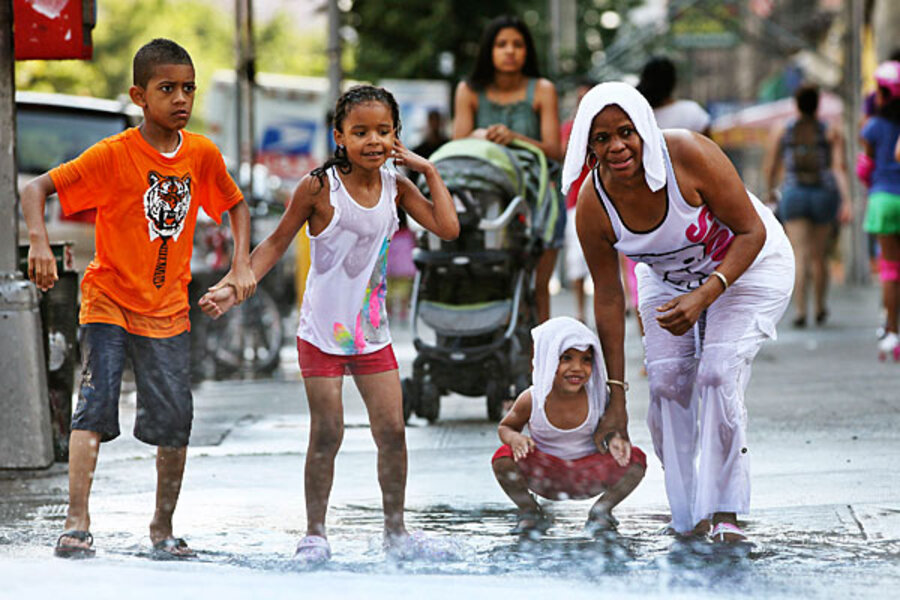Heat wave, Day 2: How are people seeking relief?
Loading...
| New York
As the heat wave hits Day 2, residents, businesses, and communities in the eastern part of the United States are trying to cope with near-100 degree temperatures and high humidity.
In Philadelphia, this means the Free Library is staying open later to help residents who can’t afford air conditioning get a respite from the heat.
Simon Property Group, a larger owner of malls, is reducing the amount of electricity it uses in 13 malls in the East, as part of its agreements with electric suppliers.
And in New York City, Con Edison decided to reduce voltage by 5 percent to some neighborhoods in Brooklyn and Queens, and it’s asking residents there not to use washers, dryers, and air conditioners.
“So far so good,” says Jim Owen, a spokesman for the Edison Electric Institute in Washington, which represents the power industry. “No significant problems detected in the Middle Atlantic and Northeast at this point.”
Yes, the temperatures are rising, but so far most people, businesses, and communities seem to be finding ways to survive the heat and cut their power usage as much as possible. Some efforts are the result of lessons learned from past heat waves – such as the importance of providing cooling stations for senior citizens and the vulnerable.
That’s the case in Philadelphia and other cities where cooling centers have opened for those who need to get out of the heat.
The Free Library volunteered last year to be part of Philadelphia’s “excessive heat” plan. “The city contacted us right away,” says Siobhan Reardon, president of the Free Library. “We have air conditioning, chairs, and good reading material.”
In addition, she says, the library has lots of space for families. “I do expect to be inundated with children and families on days like this,” she says. Indeed, since the heat wave began, the library’s branches have seen an uptick in visitors, Ms. Reardon says.
Utilities are also encouraging customers to cut back as much as possible since power demand is expected to peak later in the day as temperatures near 100 degrees.
“Utilities are wisely encouraging their customers to conserve electricity whenever possible and take all necessary safety precautions during this extreme heat,” Mr. Owen says.
One precaution: getting large customers such as mall operators to cut back on their electricity consumption. In the case of Simon Property Group, this entails turning off lighting that is not essential, reducing the speed of fans that help to circulate air, and possibly turning off chiller units for a short period of time.
“We may agree to let the temperature creep up a tad,” says George Caraghiaur, senior vice president for energy and procurement at Simon, which is based in Indianapolis. “We want it to be safe and comfortable for shoppers.”
Mr. Caraghiaur says that Simon realizes if it does nothing, there is a larger risk of brownouts and blackouts. “It’s in our best interest also,” he says.
The need to save electricity is a lesson learned last summer in Texas, when a prolonged heat wave meant 68 consecutive days of temperatures above 100 degrees. As the heat took its toll, the state had rolling brownouts and curtailments to large electricity users.
“Even in a state like Texas, we did not have the power reserves to cover that brutal heat,” says Bruce Bullock, director of the Maguire Energy Institute at Southern Methodist University in Dallas.
To save electricity, Mr. Bullock recommends that households, especially those that are empty during the day, have thermostats turned up to 78 degrees. “And try not to have two or three power-sucking, widescreen TVs going on at the same time,” he advises. “It’s critical to conserve, especially between 2 p.m. and 7 p.m.”
In Houston, Bullock says, some businesses decided to ask employees to work an extra hour per day, in return for getting every other Friday off.
“That does conserve energy in the sense that a business is not taking juice off the grid for a whole day, especially in peak hours,” he says.







